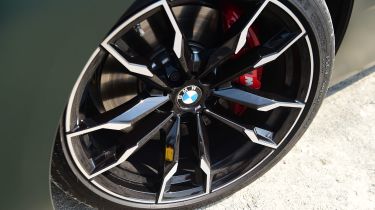Performance tyres pros and cons: should you fit high performance or ultra high performance tyres to your car?
Here is a guide on when, and when not, to fit performance tyres to your car

Tyres are one of the most important components fitted to your car. That’s not just for safety reasons though, but also to maximise your car’s performance – which is where dedicated high performance and ultra high performance tyres come in.
These days you’ll typically find these tyres fitted on high-performance cars, and that’s a good sign that when it comes time for replacement, you should look into fitting something similar to preserve your car’s abilities, whether on road or track.
Below, we explain what high performance tyres are, why you might need them, some of the pros and cons, and what you can expect to pay.
What are high performance tyres?
In a line, high performance tyres are tyres primarily designed for spirited driving and higher-performance cars. They’re typically either fitted as original equipment, or at least offered as an optional upgrade, on cars like hot hatchbacks, sports cars, high-performance SUVs, supercars, hypercars, and other vehicles designed primarily for speed.
They differ from regular tyres in several key ways, such as construction, compound, and tread pattern. Construction means characteristics such as their size, stiffness, and sidewall, and while this varies from tyre to tyre, you’ll typically find high performance tyres are wider, have a slightly squarer aspect (less of a curve between the tread and the sidewall, to maximise the amount of rubber on the road), and a shallower, stiffer sidewall.
Compound refers to the materials the tyre is made from. A high-performance tyre will typically have a softer compound than an all-season or eco tyre, designed to maximise friction for cornering grip, and to quickly get up to a temperature where the tyre can further maximise its grip. These characteristics sometimes come at the expense of longevity, however.
High performance tyre tread patterns also tend to be a little different. They’re still designed to work well in wet weather, but the tyre will often have been designed with putting as much rubber on the road as possible, and this can mean fewer tread grooves. Another useful side-effect of this is that the tread blocks don’t move around as much in high-performance driving, something that can introduce extra heat into the tyre and cause it to lose grip.
The terms ‘high performance tyres’ and ‘ultra high performance tyres’ do encompass a fairly wide range of products, but ultimately all are designed to maximise the dynamic performance of the car they’re fitted to – with ultra high performance naturally being a step further on in terms of all the characteristics above.
What are the benefits of high performance tyres?
Fitting high-performance tyres to your car will result in benefits in just about every dynamic area, particularly if you choose one of the better offerings on the market.
Very broadly, you should see an increase in adhesion, which has knock-on effects for acceleration, cornering, and braking. The car will have more traction off the line, hold its line for longer in a fast corner, and have more grip available when you’re braking very hard.
While the softer compounds of some high performance tyres may result in a shorter tyre life overall, these tyres should also offer wear and endurance benefits in short term situations like track days. A good high-performance tyre won’t overheat as quickly or destroy its tread blocks as easily as a regular tyre under these demanding conditions.
There are less objective benefits, too, which may be just as important for driving enthusiasts. A good high-performance tyre won’t just grip better, but it may also result in better steering response, improved feedback, and have more predictable ‘breakaway’ characteristics – the point when you drive beyond the tyre’s limit of grip.
What are the downsides of high performance tyres?
As hinted earlier, tyre life can be shorter on high performance tyres. That does vary from brand to brand and tyre to tyre, and there’s also the variable that you may simply drive harder on a high performance tyre, wearing it down quicker. But softer compounds tend to result in accelerated wear, so you may need to get your tyres changed more regularly.
These tyres can also be a little noisier on the road, increase your fuel consumption (thanks to their higher friction qualities), and certain tyres may not perform as well in wet or cold weather as all-season tyres – certain high-performance tyres can be quite unnerving on colder roads, as they struggle to generate enough heat to yield their grip.
Some tyres can also be a little difficult to get hold of, particularly if you have a car with much larger wheels and wider tyres, or a special manufacturer-recommended tyre, which may not be available from stock at your local tyre fitter – it’s not unusual for drivers to get a puncture and have to wait days for a replacement.
Then there’s the cost – something we cover in more detail below.
Should I fit high performance tyres to my car?
If you have a performance car and want to enjoy it to its fullest, then high performance tyres are an essential purchase. Not all tyres are created equal but by and large, your car will drive at its best on tyres designed to maximise its abilities. That means better grip, but also better feedback, something that many driving enthusiasts crave from their cars. These characteristics are so important that more and more carmakers are working directly with tyre manufacturers to create bespoke rubber for their cars – something to keep an eye out for when you’re shopping for a new set.
How much do high performance tyres cost?
Perhaps the most obvious downside of high performance tyres is cost. Where a basic tyre for a Volkswagen Golf GTI from a little-known brand might cost you £100 per corner, you’re looking at more like £150 for a Michelin Pilot Sport 5, or nearly £200 per corner for an even stickier Michelin Pilot Super Sport better suited to track use.
This cost can escalate further on tyres bespoke to a particular model, which is often the case with supercars. It’s such a problem, in fact, that for the wildly exotic Gordon Murray-designed T.50 hypercar, one of Murray’s design stipulations was that it had to use off-the-shelf performance tyres, to make them easier to find and to keep the cost of changes to a minimum.
Subscribe to the UK's favourite car magazine: get Auto Express delivered every week...
Find a car with the experts





